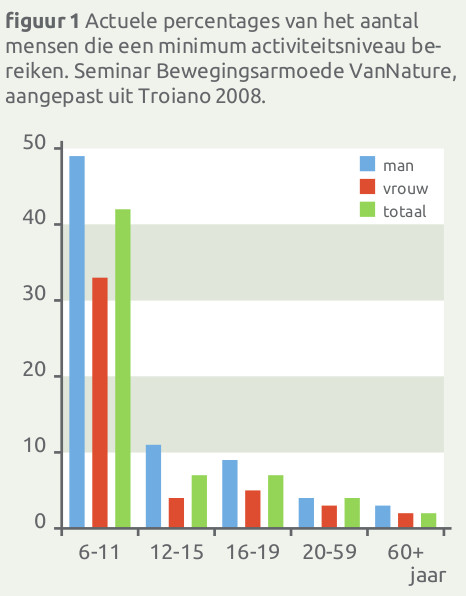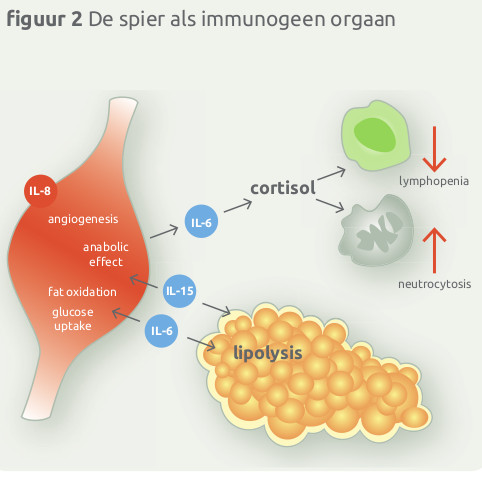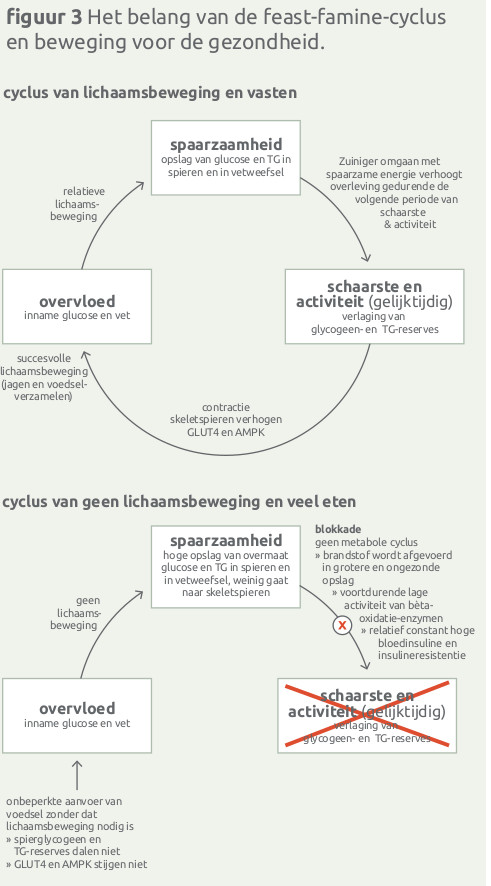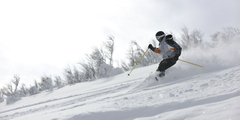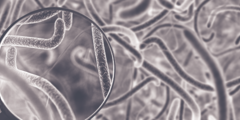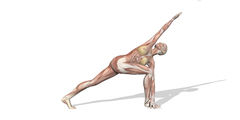
De mens is gemaakt om te bewegen. Niet bewegen (sedentariteit) staat gelijk aan langzaam aftakelen, een langzame dood dus. Het belang van bewegen voor de mens werd evolutionair bepaald: de ‘oermens’ moest bewegen om te overleven. En daarom is gans de humane fysiologie gebaseerd op beweging.
Beste bezoeker, u heeft geen toegang.
Enkel (web)abonnees hebben toegang tot tijdschriftartikelen. Het webabonnement is nog in de maak.
U kunt zich wel alvast (gratis) registreren en tal van andere webartikelen raadplegen!
Auteur
Verschenen in
Referenties
p { margin-bottom: 2.12mm; direction: ltr; color: rgb(0, 0, 0); }p.western { font-family: "Times New Roman",serif; font-size: 12pt; }p.cjk { font-family: "Times New Roman",serif; font-size: 12pt; }p.ctl { font-family: "Times New Roman",serif; font-size: 12pt; }a:link { color: rgb(0, 0, 255); }
Cordain L, Friel J. The Paleolithic Athlete: The Original Cross Trainer. In: Anthropology of Sport and Human Movement, Sands R. (Ed.), Lexington Books, 2010, pp. 267-276.
O'Keefe JH, Vogel R, Lavie CJ, Cordain L. Exercise Like a Hunter-Gatherer: A Prescription for Organic Physical Fitness. Progr Cardiovasc Dis 2011; 53:471-479.
Carrera-Bastos P, Fontes Villalba M, O’Keefe JH, Lindeberg S, Cordain L. The western diet and lifestyle and diseases of civilization. Res Rep Clin Cardiol 2011; 2: 215-235.
Chakravarthy MV, Booth FW. Eating, exercise, and “thrifty” genotypes: connecting the dots toward an evolutionary understanding of modern chronic diseases. J Appl Physiol 2004; 96(1):3-10.
O'Keefe JH, Vogel R, Lavie CJ, Cordain L. Organic fitness: Physical Activity Consistent with Our Hunter-Gatherer Heritage. Phys & Sports Med 2010; 4(38):1-8.
Prasad DS, Das BC. Physical inactivity: a cardiovascular risk factor. Indian J Med Sci. 2009 Jan;63(1):33-42.
Cordain L, Gotshall RW, Eaton SB, Eaton SB III. Physical activity, energy expenditure and fitness: an evolutionary perspective. Int J Sports Med 1998; 19:328-335.
Campbell MC, Tishkoff SA. The evolution of human genetic and phenotypic variation in Africa. Curr Biol 2010; 20:R166-R173.
Steudel-Numbers KL, Wall-Scheffler CM. Optimal running speed and the evolution of hominin hunting strategies. J Human Evolution 2009; 56:355-360.
O’Keefe JH, Vogel R, Lavie CJ, Cordain L. Exercise Like a Hunter Gatherer: A Prescription for Organic Physical Fitness. Progress in Cardiovascular Disease, 2011;56:471-479.
Cordain L, Gotshall, Eaton B. Evolutionary aspects of exercise. Exercise and Evolution. Uit:
Simopoulos AP. Nutrition and Fitness: Evolutionary Aspects. World Rev Nutr Diet. Karger 1997; 81:49-60.
Liebenberg, L. Persistence hunting by modern hunter-gatherers. Current Anthropology 2006; 47:1017.
Lightfoot, J. T. Current understanding of the genetic basis for physical activity. J Nutr 2011; 141:526-530.
Liebenberg, L. The relevance of persistence hunting to human evolution. J human evolution 2008; 55:1156.
Raichlen DA, Polk JD. Linking brains and brawn: exercise and the evolution of human neurobiology. Proc Biol Sci. 2013 Jan 7;280(1750):20122250.
Mattson MP. Energy Intake and Exercise as Determinants of Brain Health and Vulnerability to Injury and Disease. Cell Metab. 2012; pii: S1550-4131(12)00402-0.
Rothman SM, Mattson MP. Activity-dependent, stress-responsive BDNF signaling and the quest for optimal brain health and resilience throughout the lifespan. Neuroscience. 2012 Oct 16: S0306-4522(12)01022-6.
Zollikofer CP, De León MS. Pandora's growing box: Inferring the evolution and development of hominin brains from endocasts. Evol Anthropol. 2013 Jan-Feb;22(1):20-33.
Raichlen DA, Gordon AD Relationship between Exercise Capacity and Brain Size in Mammals. Plos One 2011; 6(6):e20601. www.plosone.org
Booth FW, Chakravarthy MV, Spangenburg EE. Exercise and gene expression: physiological regulation of the human genome through physical activity. J Physiol 2002; 543:399-411
Eaton SB, Cordain L, Sparling PB, Cantwell JD. Evolution, body composition and insulin resistance. Preventive Medicine, 2009;49:283-285.
Eaton SB, Eaton SB. An evolutionary perspective on human physical activity: implications for health. Comp Biochem Physiol a Mol Integr Physiol. 2003; 136(1):153–9.
Pruimboom L. Bewegingsarmoede, de bron van veel gezondheidsproblemen. Seminar Natura Foundation, 2011.
Charansonney OL, Després JP. Disease prevention-should we target obesity or sedentary lifestyle? Nat Rev Cardiol 2010; 7(8):468–472.
O’Keefe J.H., Cordain L. Cardiovascular disease as a result of a diet and lifestyle at odds with our Paleolithic genome: how to become a 21st century hunter-gatherer. Mayo Clin Proc 2004; 79:101-108.
Booth FW, Lees SJ. Fundamental questions about genes, inactivity, and chronic diseases. Physiol Genomics 2007; 28:146-157.
Eaton SB, Konner M, Shostak M. Stone agers in the fast lane: chronic degenerative diseases in evolutionary perspective. Am J Med. 1988;84:739-749.
Straub, RH.; Besedovsky, HO. Integrated evolutionary, immunological, and neuroendocrine framework for the pathogenesis of chronic disabling inflammatory diseases. FASEB J 2003; 17(15):2176–2183.
Pruimboom L, Stark M, Fox T, Kool M. De pandemie van chronische aandoeningen. Van Nature 2009; 15:22 – 28.
Neel JV, Weder AB, Julius S. Type II diabetes, essential hypertension, and obesity as "syndromes of impaired genetic homeostasis": the "thrifty genotype" hypothesis enters the 21st century. Perspect. Biol. Med. 1998; 42(1):44–74.
Williams, George; Nesse, Randolph M. Evolution and healing. Why We Get Sick: the new science of Darwinian medicine. New York Vintage Books. 1996: 37–8.
Booth FW, Roberts CK. Linking performance and chronic disease risk: indices of physical performance are surrogates for health. Br J Sports Med 2008; 42:950-952.
Booth FW, Chakravarthy MV, Gordon SE, Spangenburg EE. Waging war on physical inactivity: using modern molecular ammunition against an ancient enemy. J Appl Physiol 2002; 93:3-30
Booth FW, Gordon SE, Booth FW, Carlson CJ, Hamilton MT. Waging war on modern chronic diseases: primary prevention through exercise biology. J Appl Physiol 2000; 88:774-787.
Lees SJ, Booth FW. Physical inactivity is a disease. World Rev Nutr Diet 2005; 95:73-79.
Pruimboom L. Physical inactivity is a disease synonymous for a non-permissive braindisorder. Medical Hypotheses 2011; 77(5):708-13.
Lees SJ, Booth FW. Sedentary death syndrome. Appl Physiol, Nutr & Metabol 2004; 29:447-460.
Pruimboom L. The non-permissive brain. Van Nature 2008; 10:39 – 42.
Vogiatzis I, Zakynthinos S. Physical inactivity: common pathway to peripheral muscle weakness in chronic respiratory diseases? Eur Respir J 2009; 34(6):1213-1214.
Chakravarthy MV, Booth FW. Eating, exercise, and "thrifty" genotypes: connecting the dots toward an evolutionary understanding of modern chronic diseases. J Appl Physiol 2004; 96:3-10.
Pruimboom L. Sport en spel, blessures als bijkomstigheid van een gezond leven. Seminar Natura Foundation, 2011.
Gomez-Cabrera MC et al. Moderate exercise is an antioxidant : Upregulation of antioxidant genes by training. Free Radic Biol Med 2007; 0891-5849/$.
Stranahan, Alexis M, Kim Lee, and Mark P Mattson. Central Mechanisms of HPA Axis Regulation by Voluntary Exercise. Neuromol Med 2008; 10(2):951-961.
Reichardt LF. Neurotrophin-regulated signalling pathways. Philos Trans R Soc Lond B Biol Sci. 2006 Sep 29;361(1473):1545-64.
Novak, Colleen M, Kotz CM, Levine J. Central orexin sensitivity, physical activity, and obesity in diet-induced obese and diet-resistant rats. Am J Physiol Endocrinol Metab 2006; 290:396-403
Taylor MM, Samson WK. The other side of the orexins: endocrine and metabolic actions. Am J Physiol Endocrinol Metab 2003; 284:E13-17.
Teske JA, Billington CJ, Kotz CM. Neuropeptidergic Mediators of Spontaneous Physical Activity and Non-Exercise Activity Thermogenesis. Neuroendocrinology 2008; 87(2):71-90.
Thorburn AW, Proietto J. Biological Determinants of Spontaneous Physical Activity. Obes Rev. 2000 Oct;1(2):87-94.
Nielsen S, Pedersen BK. Skeletal muscle as an immunogenic organ. Current Opinion Pharmacol 2008; 8:346-351.
Barnes MJ, Jen KL, Dunbar JC. The effect of CNS opioid on autonomic nervous and cardiovascular responses in diet-induced obese rats. Peptides 2004;25(1):71-9.
Walsh NP et al. Position Statement. Part one: Immune function and exercise. EIR 2011; 17:6-63.
Pruimboom L, van Dam AC. Chronic pain: a non-use disease. Med Hypotheses 2007; 68: 5 06-511
Pruimboom L, Fox T. Nahrung und Bewegung – ein erfahrenes Team. Sportphysiotherapie, Thieme Verlag 2011; 337 – 377.
Cordain L, Eaton SB et al. Origins and evolution of the Western diet: health implications for the 21st century. Am J Clin Nutr February 2005 81: 341-354
Abuissa H, O’Keefe JH, Cordain, L. Realigning our 21st century diet and lifestyle with our hunter-gatherer genetic identity. Directions Psych 2005;25: SR1-SR10.
O'Keefe JH, Vogel R, Lavie CJ, Cordain L. Achieving hunter-gatherer fitness in the 21(st) century: back to the future. Am J Med. 2010 Dec;123(12):1082-6.
Eaton SB, Strassman BI, Nesse RM, Neel JV, Ewald PW, Williams GC, Weder AB, Eaton SB 3rd, Lindeberg S, Konner MJ, Mysterud I, Cordain L. Evolutionary health promotion. Prev Med 2002; 34(2):109–18.
Nesse RM et al. Making evolutionary biology a basic science for medicine. PNAS 2009; 107 S1:1800–7.
Spence JC, Lee RE. Toward a comprehensive model of physical activity. Psych Sport exerc 2003; 4:7-24.
Van Dam B. De keerzijde van de medaille. VanNature 2007; 4:34-35.
Pruimboom L. Neurotraining, een holistische kijk op sport. VanNature 2007; 4:26-29.
O'Keefe JH Jr, Cordain L. Cardiovascular disease resulting from a diet and lifestyle at odds with our Paleolithic genome: how to become a 21st-century hunter-gatherer. Mayo Clin Proc. 2004;79:101-108.
Thompson PD. Exercise and physical activity in the prevention and treatment of atherosclerotic cardiovascular disease. Arterioscler Thromb Vasc Biol. 2003;23:1319-1321.
Byberg L et al. Total mortality after changes in leisure time physical activity in 50 year old men: 35 year follow-up of population based cohort. BMJ. 2009; 5;338:b688.
Berry JD et al . Physical Fitness and Risk for Heart Failure and Coronary Artery Disease. Circ Heart Fail. 2013 May 15. [Epub ahead of print]
Willis BL et al. Midlife fitness and the development of chronic conditions in later life. Arch Intern Med. 2012; 24;172(17):1333-40.
Liu R. et al. Cardiorespiratory fitness as a predictor of dementia mortality in men and women. Med Sci Sports Exerc. 2012 Feb;44(2):253-9.
Bertelli R et al. Association amongst physical activity, aging and dementia. Acta Med Port. 2011 Sep-Oct;24(5):771-4.
Martin BJ et al. Cardiovascular fitness and mortality after contemporary cardiac rehabilitation. Mayo Clin Proc. 2013 May;88(5):455-63.
Stovitz SD. Contributions of fitness and physical activity to reducing mortality. Clin J Sport Med. 2012 Jul;22(4):380-1.
Fernhall B. Long-term aerobic exercise maintains peak VO(2), improves quality of life, and reduces hospitalisations and mortality in patients with heart failure. J Physiother. 2013;59(1):56.
Petersen CB et al.Changes in physical activity in leisure time and the risk of myocardial infarction, ischemic heart disease, and all-cause mortality. Eur J Epidemiol. 2012 Feb;27(2):91-9.
Wolin KY et al. Change in physical activity and colon cancer incidence and mortality. Cancer Epidemiol Biomarkers Prev. 2010 Dec;19(12):3000-4.
Carmichael AR et al. Physical activity and breast cancer outcome: a brief review of evidence, current practice and future direction. Eur J Surg Oncol. 2010 Dec;36(12):1139-48.
Troiano RP, Berrigan D, Dodd KW, Mâsse LC, Tilert T, McDowell M. Physical activity in the United States measured by accelerometer. Medicine & Science in Sports & Exercise. 2008;40(1):181–188

